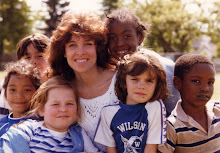And each Christmas season brings a visit from Emily, one of my amazing Pacific Oaks
 College students. She is now working as a teacher educator in Nashville, and is the mom to two incredible young kids. We have stayed in touch for a decade, and nothing has been more touching than the photograph she sent of Anna, just ten months old, reading books to herself. This "simple joy and beautiful thing to see," as Emily described in her journal, got us talking about literacy once again.
College students. She is now working as a teacher educator in Nashville, and is the mom to two incredible young kids. We have stayed in touch for a decade, and nothing has been more touching than the photograph she sent of Anna, just ten months old, reading books to herself. This "simple joy and beautiful thing to see," as Emily described in her journal, got us talking about literacy once again.Now Anna is a kindergartner, and Emily and I are corresponding about Anna's early reading instruction, as well as Emily's work with pre-service teachers. We've agreed to post some of her questions here so others can have the benefit of her insights and questions, and my attempts to address them. Her questions are similar to those of Jacqueline.
So for tonight, I've pasted in comments and questions from Emily, and over the next week, we can continue the conversation. Stay tuned.
EMILY'S QUESTIONS
In light of a balanced literacy approach that you advocate, what do you think of sight word flashcards and things like that? I am seeing a lot of this in a different light as Anna has been learning to read this year. I see her being asked to do flashcards and there are quite a few worksheets that come out of her class. I am trying to figure out what a real balanced literacy class looks like (as they say that they use balanced literacy, but it seems that perhaps it has a heavier leaning toward the phonics.)
What do you recommend as far as a specific reading curriculum? (If we don't use the textbooks, what is the best way to supplement the curriculum if teachers are just starting out with few resources?)
Would you remind me of the exact context in which you used the coded reading books (phonics, skills, holistic) in our Language and Literacy class? [Note: Emily borrowed these coded texts from me this winter so that she could use them with her own students.] What was the objective in relation to the rest of what you had already been working with us on? I just want to make sure that I am using this experience to its maximum potential! I remember it being powerful because I had been teaching Distar (which was hard for me to swallow) and this showed me how some kids might view it.
I was reading the book New Policy Guidelines for Reading and loved that page that showed the writing samples from the three different classrooms. In classrooms where real literature is used, it seems that everything improves (reading, writing, language in general). Is this going to hit the mid to higher readers or will it hit everyone from your experience? (I am trying to think about some of my struggling readers and writers and wondering if I would have seen that kind of writing from them-- the kind in the final sample.)
What about the kids who are really struggling? I remember when I was at XYZ school that some of the folks brought in Distar because they wanted to make sure that the kids had a phonics background. They were concerned that they had no foundation with this so they chose this route. (And it totally bored the higher-level readers. I recall that this was not really engaging for the struggling readers either--it just seemed that folks thought that we had to give this foundation or they would not get it from the other literature).
Also, what about Reading Recovery models? Don't they just go back to the phonics? Hmm--are we doing this all wrong? Do we just need to get to reading good literature? Doesn't "balanced literacy" try to focus on some phonics too?




No comments:
Post a Comment